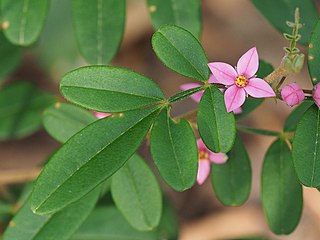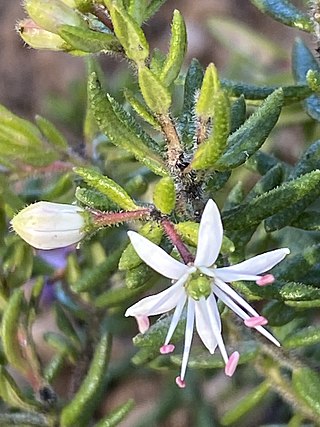
Leionema elatius, commonly known as tall phebalium, is a shrub species that is endemic to New South Wales and Queensland in Australia. It has glossy green, variably-shaped leaves and clusters of white-lemon flowers in spring.

Leionema dentatum, commonly known as toothed phebalium is a species of large shrub or small tree that is endemic to New South Wales, Australia. It has variable leaves, slender branches and clusters of cream-yellow flowers in spring.

Boronia umbellata, commonly known as the Orara boronia, is a plant in the citrus family Rutaceae and is endemic to a small area on the north coast of New South Wales. It is an erect shrub with many branches, aromatic, pinnate leaves and clusters of up to ten dark pink flowers in the leaf axils.

Boronia warrumbunglensis is a plant in the citrus family Rutaceae and is endemic to a small area in the central west of New South Wales. It is a shrub with many branches, pinnate leaves and one or two pink, four-petalled flowers in the leaf axils. It is only known from the Warrumbungles and nearby districts.

Boronia parviflora, commonly known as the swamp boronia, small boronia, tiny boronia, or small-flowered boronia, is a plant in the citrus family Rutaceae and is endemic south-eastern Australia. It is a weak, low shrub with elliptic to egg-shaped leaves with finely toothed edges and up to three pink, white or green four-petalled flowers arranged at or near the ends of the stems.

Leionema carruthersii is a small shrub that is endemic to southern New South Wales in Australia. It has mostly greenish-yellow flowers, distinctive stamens and lance to egg-shaped leaves.
Leionema ceratogynum is a dense shrub, it grows on the south coast of New South Wales, Australia. It has oval-elliptic shaped leaves, scented foliage and lemon flowers usually in groups of three arising from the leaf axils.

Leionema diosmeum is a shrub species in the family Rutaceae that is endemic to southern New South Wales, Australia. It has an upright habit, stems with fine soft hairs, variable shaped leaves and yellow flowers from late winter to spring.

Leionema ellipticum is a shrub species that is endemic to Queensland in Australia. It is a small shrub with smooth green leaves and creamy-white flowers in spring.
Leionema equestre, commonly known as Kangaroo Island phebalium, is a shrub species that is endemic to South Australia. It is a small spreading shrub with rough, green leaves and whitish-pink flowers from late winter to October.

Leionema gracile, commonly known as Mt Greville phebalium, is a shrub species that is endemic to Queensland, Australia. It is a small shrub with spreading leaves, white petals and flowers from autumn to spring.
Leionema lachnaeoides, is a tall shrub with aromatic leaves and yellow flowers from winter to late spring. It is restricted to the Blue Mountains in New South Wales.

Leionema microphyllum, commonly known as limestone phebalium, is a small shrub with terminal clusters of white-pink flowers in spring. It is a rare plant in Victoria and South Australia.

Phebalium festivum, commonly known as dainty phebalium, is a species of spreading shrub that is endemic to Victoria, Australia. It has smooth branchlets, broadly egg-shaped, warty leaves and three to ten white or pale yellow flowers arranged in umbels on the ends of branchlets.

Phebalium verrucosum is a species of shrub that is endemic to New South Wales. It has branchlets densely covered with white scales, narrow elliptic, oblong or linear leaves covered with white scales on the lower side, and umbels of creamy white flowers with silvery or rust-coloured scales on the back of the petals.

Asterolasia beckersii, commonly known as Dungowan starbush, is a species of erect shrub in the family Rutaceae and is endemic to a restricted area of New South Wales. It has woolly, star-shaped hairs on its branchlets, egg-shaped to lance-shaped leaves with the narrower end towards the base and covered with star-shaped hairs, and white flowers arranged singly in leaf axils, the back of the petals covered with star-like hairs.

Asterolasia correifolia is a species of erect shrub that is endemic to eastern Australia. It has white to brown star-shaped hairs on its stems, lance-shaped to elliptical leaves densely covered with white star-shaped hairs on the lower surface, and white to cream-coloured or yellow flowers arranged in umbels of four to ten or more in leaf axils, the back of the petals densely covered with white hairs.
Leionema scopulinum, is an upright shrub with glossy, dark green, narrow leaves and yellow flowers from autumn to spring. It is found in the Wollemi National Park in New South Wales.

Pomaderris walshii, commonly known as Carrington Falls pomaderris, is a species of flowering plant in the family Rhamnaceae and is endemic to a restricted area of New South Wales. It is a shrub or small tree with hairy young stems, narrowly egg-shaped leaves, and panicles of cream-coloured to yellow flowers.

Leionema westonii is a flowering plant in the family Rutaceae and is endemic to New South Wales. It has white flowers borne in upper leaf axils.
















